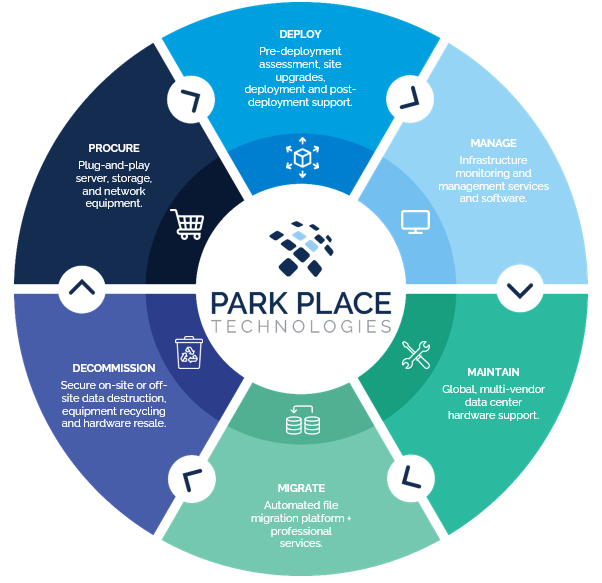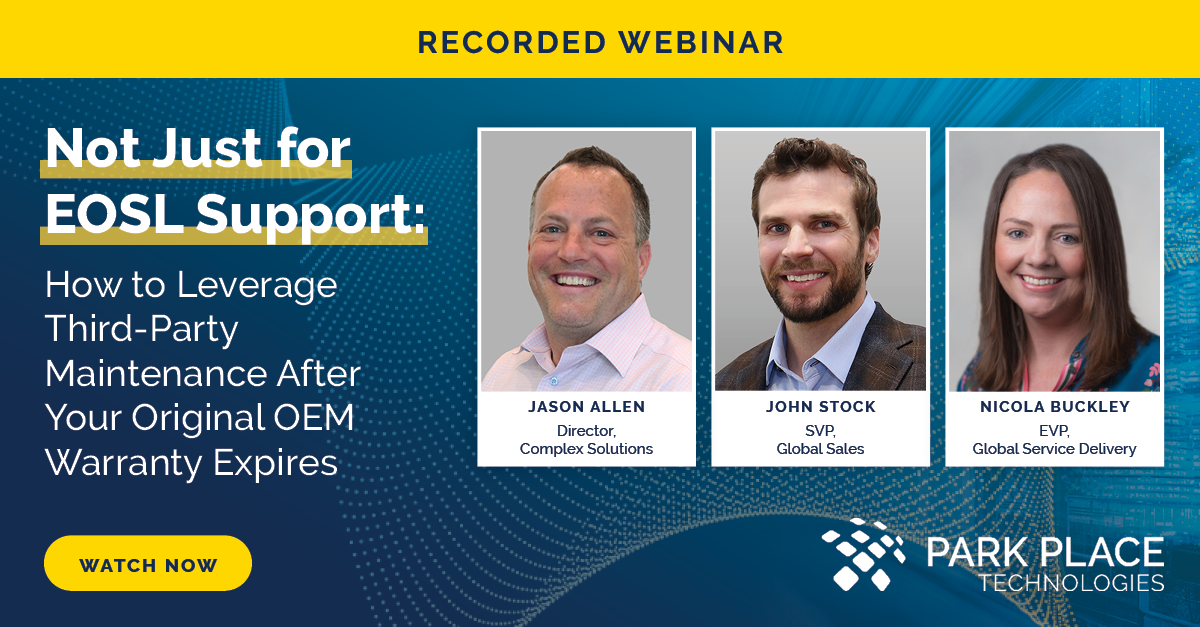Hardware Lifecycle Management – Maximizing Value at Every Stage
Park Place Hardware Maintenance
Unfortunately, nothing lasts forever. Every piece of equipment within your data center has an expected lifecycle — a period of time over which infrastructure will function effectively. Throughout this lifecycle components wear down, causing a deterioration in performance at best or complete system failure at worst.
Still, there are steps you can take throughout the hardware lifecycle to mitigate this deterioration in a way that maximizes value at each phase. Continue reading to learn how to optimize both performance and cost throughout the entirety of your hardware’s life:
What Is Hardware Lifecycle Management?
Hardware lifecycle management is a holistic approach to managing the total useful life of IT infrastructure that maximizes the return on investment. Since most organizations tend to accumulate IT assets over time, it can be difficult to keep track of where each piece of hardware is at in its lifecycle.

However, managing and monitoring equipment throughout its life is essential to having a leg-up on the lifespan of your infrastructure. But be aware, hardware lifecycle management is a multi-step process that requires your dedicated time and attention.
The Benefits:
By considering the entire useful life of your storage, compute, or networking devices, lifecycle management practices allow businesses to:
- lower hardware and maintenance costs in the data center
- increase upgrade flexibility
- extend the useful life of hardware (5-10 years beyond EOSL)
- lower Total Cost of Ownership (TCO)
- maximize the value of IT investments (improve ROI)
IT Hardware Lifecycle Stages
1. Procurement
The initial step in any hardware lifecycle is the purchase of the device itself. It’s important to consider more than price and performance, however. Purchases should take both the existing and future needs of an organization into account. It makes little sense to buy a cheap, underpowered server that’s “good enough” for today if more capacity will be needed before the end of its expected lifecycle. But at the same time, organizations shouldn’t waste resources by overestimating their growth potential. Follow current IT procurement best practices, and anticipate how the supply chain could impact your strategy.
2. Deploy & Install
After hardware is procured, it will then need to be installed and integrated with existing systems. The IT deployment phase is important because a poorly optimized deployment can severely impact both performance and lifecycle. Consider a server installed in a dusty, cluttered, environment with poor air circulation; this server will undoubtedly run hotter than normal and put more strain on its components, leading to faster wear down.
3. Maintenance
Perhaps the most important step in hardware lifecycle management, assets need to be carefully monitored and maintained over time. No equipment should ever be treated as a “set it and forget it” asset. Regular inspections need to be carried out, whether manually or with the help of data center hardware monitoring system, to ensure that hardware is operating effectively and performance isn’t depreciating.
A simple maintenance schedule for EOL or EOSL hardware can often spot and repair minor issues before they compound into more serious problems that require the provision of entirely new equipment.
4. Upgrades
In addition to maintenance, hardware and software need ongoing support throughout their lifecycle in the form of updates. Perform regular audits to identify necessary upgrades. It’s best to maintain a regular schedule for audits in the lifecycle management process to ensure they never get backed-up, and consequently shorten the lifespan of the devices.
If your team isn’t set up to handle this task, employ the help of IT infrastructure managed services from an experienced company.
5. Buy-Back or Trade-In
The opportunity to sell used servers, routers, switches, or backup tape is a great option for data center professionals that want to securely retire equipment. Working with a company like Park Place Technologies, you can rest easy with the assurance that all pre-owned hardware will be extensively wiped and securely destroyed or repurposed.
6. Disposal & Refresh
The last step of the lifecycle management process is to dispose of current hardware in exchange for new. Unfortunately, even well-maintained and regularly updated equipment eventually breaks down or reaches a point where the risk of failure becomes too great to ignore. Thus, it is the goal of hardware lifecycle management to dispose of and replace assets before they become a burden. And if an organization has been managing its hardware effectively, the disposal step should never come as a surprise!
Two Additional Steps:
1. IT Asset Disposition (ITAD) Services
According to a report from Gartner, “ITAD services have become an important link in the overall lifecycle management of IT equipment.” Consider that disposing of used servers, storage, and networking equipment on your own is expensive, time-consuming, and difficult. Not only must you comply with federal, state, and local electronics disposal laws, you may have to ensure that any sensitive data on your hardware has been wiped or destroyed to mitigate any security risks.
With the help of Park Place Technologies’ reliable IT Asset Disposition service, you can minimize waste in your data center while simultaneously increasing the flexibility and functionality of your budget.
2. Low-Cost Alternatives with Third Party Maintenance
A common mistake many organizations make in the IT infrastructure lifecycle management process is fixating on original equipment manufacturer (OEM) support. This closed-mindedness is especially harmful when you consider that 57 – 80 percent of an IT budget goes towards maintaining existing assets! With that in mind, a critical step in the lifecycle management process is to rationalize your maintenance spend with TPM.
Third party IT maintenance exists to help IT managers avoid the hassle and expense of a forced refresh before they’re financially or strategically prepared to do so. Not only is third party maintenance 30–40% less than the OEM equivalent, but extending the lifespan of your infrastructure results in a better ROI as well as greater control over the hardware lifecycle.
Park Place Technologies is uniquely positioned to help your organization manage data center infrastructure throughout the entirety of its useful life. From procurement and deployment, to regular maintenance and upgrades, and even disposal and finally refreshes, we have the solutions your business requires to thrive. Get in touch with us today to learn how Park Place can help optimize your data center’s uptime and performance throughout each and every phase of the hardware lifecycle!



